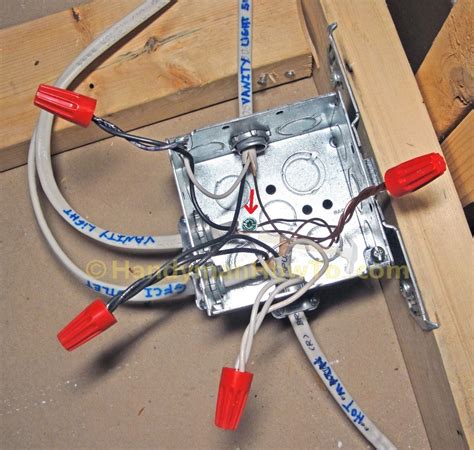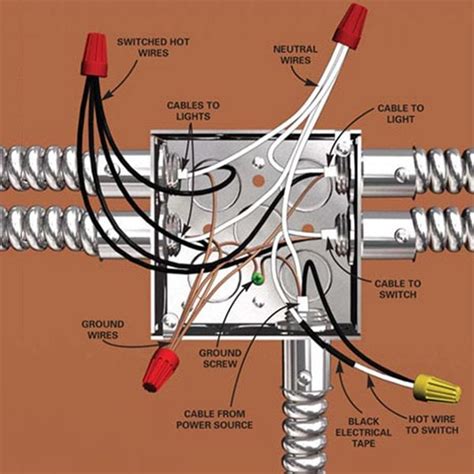correct way to secure spare wiring in a junction box Junction boxes protect electrical wires from damage, prevent shocks, and stop sparks from igniting flammable material nearby. To install . Check out our wood box with lid for metal storage selection for the very best in unique or custom, handmade pieces from our boxes & bins shops.
0 · sealing junction box wiring
1 · junction box wiring protection
2 · how to wire junction box
3 · how to cut junction box wiring
4 · how to connect junction box
5 · diy junction box wiring
6 · covering junction box wiring
7 · connecting junction box wiring
The authorized share capital of the company is Rs.26,00,000 and its paid up capital is Rs.25,00,000. Its balance sheet was last filed on 31-03-2022. WMW METAL FABRICS .
Junction boxes protect electrical wires from damage, prevent shocks, and stop sparks from igniting flammable material nearby. To install .Installing a junction box is an important step in electrical wiring projects. It provides a safe and secure enclosure for electrical connections, helps to prevent electrical fires, and allows for easy access to wiring for maintenance or . Nothing is more dangerous and aggravating than loose wires in a junction box. In this video you'll learn how to wire junction boxes correctly. You'll also se. Choose a location for your junction box that is easily accessible and complies with local electrical codes. The box should be mounted securely to a stud or joist, with its face flush to the wall surface. For exterior installations, .
Connecting Wires in the Junction Box Methods for Securing Wire Connections. When connecting wires within a junction box, it’s crucial to ensure that the connections are secure and reliable to maintain the integrity and . Article 334.30 states that cables coming out of the junction boxes should be secured within 12 inches of the box in all boxes equipped with cable clamps. These cable clamps are not to be removed. 314.17 (C) states that .
If you're running nm into the end of the pipe and down to the box, you need a fitting that clamps the cable and fits over emt. If you're coming into the back, you will also need a cable clamp. Going into the junction box I have one old cable that has the wires enclosed in the metal armor. I am also connecting two new wires (NM) 14/2's. The two new wires I have the . Secure the cables by tightening the screws on the clamps, being careful not to overtighten and damage the cables. Plastic boxes usually have spring-tabs for clamps and do not require tightening. The ends of the wires . Properly Securing and Grounding the Junction Box. After connecting the wires, secure them neatly inside the junction box. Additionally, if the box is made of metal, ensure proper grounding by connecting a ground wire to the grounding screw provided in the box. This step is crucial for safety and compliance. Testing the Installation
Junction boxes protect electrical wires from damage, prevent shocks, and stop sparks from igniting flammable material nearby. To install one, you’ll need to strip the ends off all the wires that will be in the box. To complete the electrical circuit, tie together the same-colored wires and hold them in place with wire nuts.Installing a junction box is an important step in electrical wiring projects. It provides a safe and secure enclosure for electrical connections, helps to prevent electrical fires, and allows for easy access to wiring for maintenance or repairs. Here are the steps for properly installing a junction box: 1. Choose the right junction box: Nothing is more dangerous and aggravating than loose wires in a junction box. In this video you'll learn how to wire junction boxes correctly. You'll also se. Choose a location for your junction box that is easily accessible and complies with local electrical codes. The box should be mounted securely to a stud or joist, with its face flush to the wall surface. For exterior installations, select a location that provides protection from direct exposure to the elements.
Connecting Wires in the Junction Box Methods for Securing Wire Connections. When connecting wires within a junction box, it’s crucial to ensure that the connections are secure and reliable to maintain the integrity and safety of the electrical system. Several methods can be employed to achieve this, each with its own advantages and .
sealing junction box wiring

junction box wiring protection
Article 334.30 states that cables coming out of the junction boxes should be secured within 12 inches of the box in all boxes equipped with cable clamps. These cable clamps are not to be removed. 314.17 (C) states that cables must be secured to the receptacle box. If you're running nm into the end of the pipe and down to the box, you need a fitting that clamps the cable and fits over emt. If you're coming into the back, you will also need a cable clamp.

Going into the junction box I have one old cable that has the wires enclosed in the metal armor. I am also connecting two new wires (NM) 14/2's. The two new wires I have the correct clamps that screw tighten down to secure the cables.
Secure the cables by tightening the screws on the clamps, being careful not to overtighten and damage the cables. Plastic boxes usually have spring-tabs for clamps and do not require tightening. The ends of the wires should be clean, straight, and undamaged. Properly Securing and Grounding the Junction Box. After connecting the wires, secure them neatly inside the junction box. Additionally, if the box is made of metal, ensure proper grounding by connecting a ground wire to the grounding screw provided in the box. This step is crucial for safety and compliance. Testing the Installation Junction boxes protect electrical wires from damage, prevent shocks, and stop sparks from igniting flammable material nearby. To install one, you’ll need to strip the ends off all the wires that will be in the box. To complete the electrical circuit, tie together the same-colored wires and hold them in place with wire nuts.
Installing a junction box is an important step in electrical wiring projects. It provides a safe and secure enclosure for electrical connections, helps to prevent electrical fires, and allows for easy access to wiring for maintenance or repairs. Here are the steps for properly installing a junction box: 1. Choose the right junction box: Nothing is more dangerous and aggravating than loose wires in a junction box. In this video you'll learn how to wire junction boxes correctly. You'll also se. Choose a location for your junction box that is easily accessible and complies with local electrical codes. The box should be mounted securely to a stud or joist, with its face flush to the wall surface. For exterior installations, select a location that provides protection from direct exposure to the elements.
Connecting Wires in the Junction Box Methods for Securing Wire Connections. When connecting wires within a junction box, it’s crucial to ensure that the connections are secure and reliable to maintain the integrity and safety of the electrical system. Several methods can be employed to achieve this, each with its own advantages and . Article 334.30 states that cables coming out of the junction boxes should be secured within 12 inches of the box in all boxes equipped with cable clamps. These cable clamps are not to be removed. 314.17 (C) states that cables must be secured to the receptacle box. If you're running nm into the end of the pipe and down to the box, you need a fitting that clamps the cable and fits over emt. If you're coming into the back, you will also need a cable clamp.
Going into the junction box I have one old cable that has the wires enclosed in the metal armor. I am also connecting two new wires (NM) 14/2's. The two new wires I have the correct clamps that screw tighten down to secure the cables.

how to wire junction box

solidworks sheet metal best practices
$91.43
correct way to secure spare wiring in a junction box|junction box wiring protection